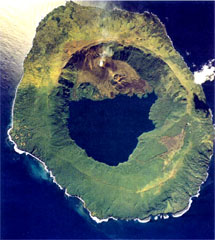Report on Tofua (Tonga) — 24 April-30 April 2024
Smithsonian Institution / US Geological Survey
Weekly Volcanic Activity Report, 24 April-30 April 2024
Managing Editor: Sally Sennert.
Please cite this report as:
Global Volcanism Program, 2024. Report on Tofua (Tonga) (Sennert, S, ed.). Weekly Volcanic Activity Report, 24 April-30 April 2024. Smithsonian Institution and US Geological Survey.
Tofua
Tonga
19.75°S, 175.07°W; summit elev. 515 m
All times are local (unless otherwise noted)
Tonga Geological Services reported that activity at Tofua increased on 26 April and was characterized as having an unusual pattern of activity. A total of 45 eruptive events were identified in data from 0956 on 26 April to 0246 on 28 April. An intensifying thermal anomaly was also identified in satellite images. At 2200 on 28 April an ash plume was identified in a satellite image rising 4-6 km above the summit and drifting NW; it was no longer visible 4 hours later. A SW-drifting plume of sulfur dioxide was also identified in a few satellite images. The number of thermal anomalies over the volcano decreased during 28-30 April, and though sulfur dioxide emissions continued to be detected, the flux had decreased. Mariners were advised to stay 2 km away from the island.
Geological Summary. The low, forested Tofua Island in the central part of the Tonga Islands group is the emergent summit of a large stratovolcano that was seen in eruption by Captain Cook in 1774. The summit contains a 5-km-wide caldera whose walls drop steeply about 500 m. Three post-caldera cones were constructed at the northern end of a cold fresh-water caldera lake, whose surface lies only 30 m above sea level. The easternmost cone has three craters and produced young basaltic andesite lava flows, some of which traveled into the caldera lake. The largest and northernmost of the cones, Lofia, has a steep-sided crater that is 70 m wide and 120 m deep and has been the source of historical eruptions, first reported in the 18th century. The fumarolically active crater of Lofia has a flat floor formed by a ponded lava flow.

